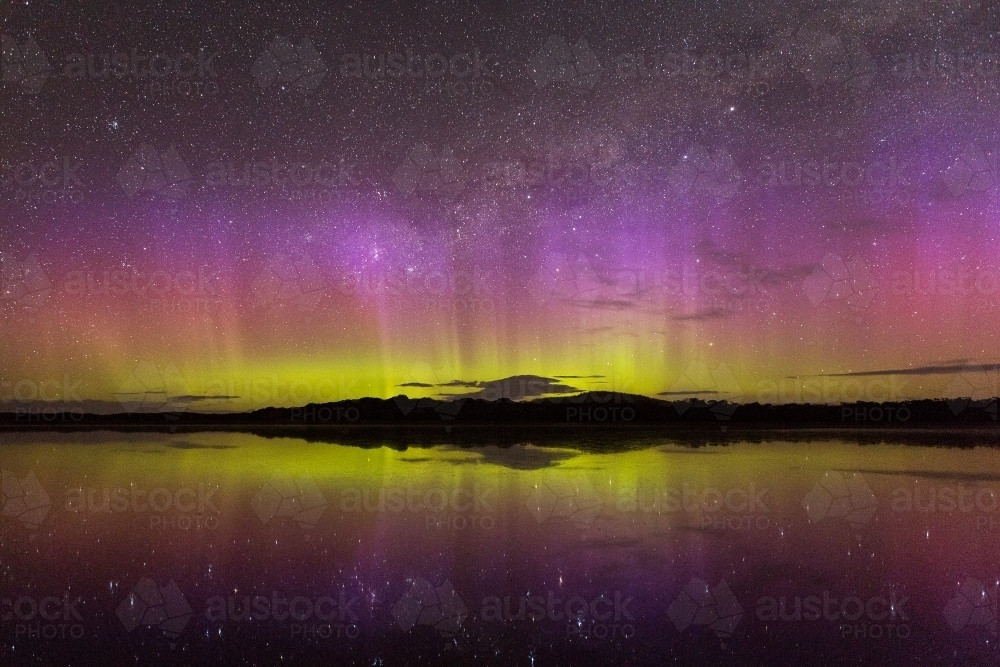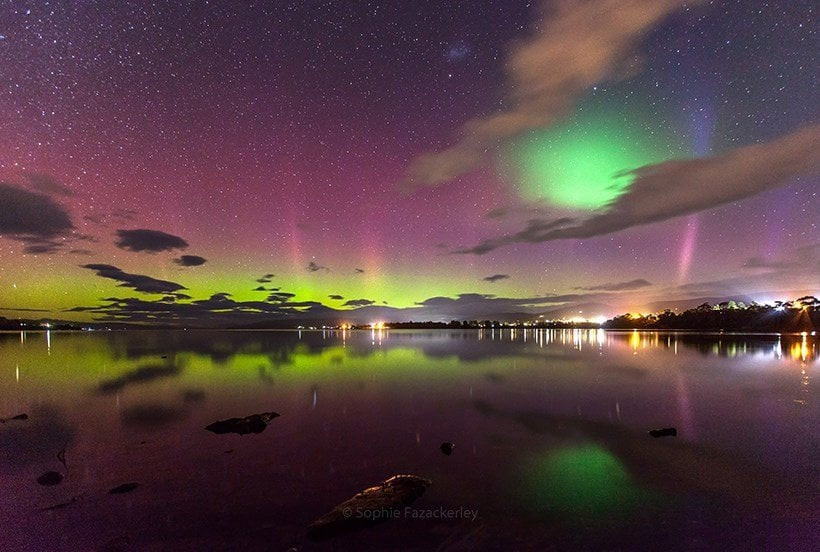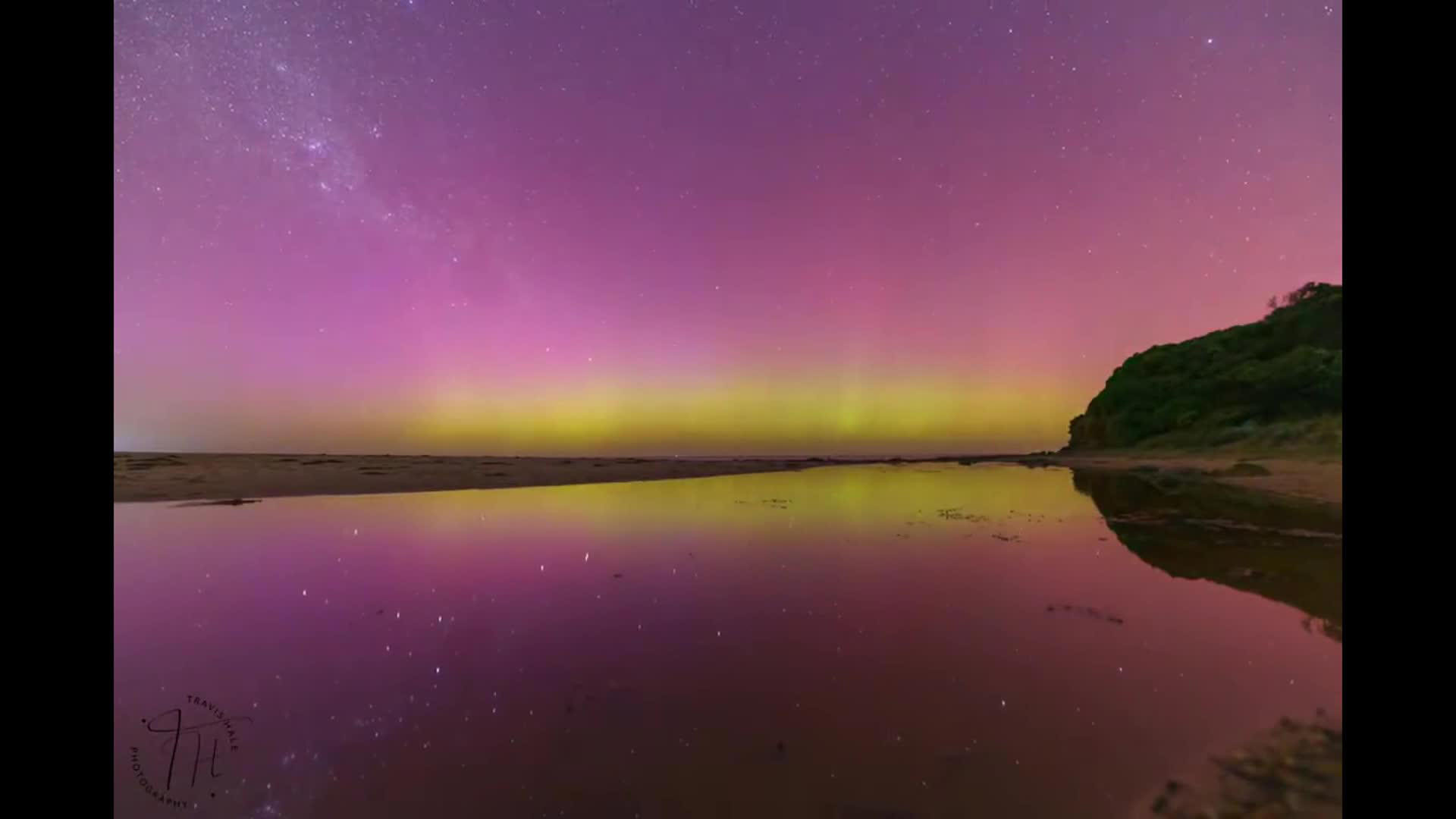Early risers have been treated to a spectacular light show, with the aurora australis visible once again in Australia's southern states on Friday morning. Caused by large expulsions of plasma and magnetic field from the Sun's corona, the phenomenon has wowed stargazers and photographers multiple times this year. Overnight, coronal mass ejection (CME) activity provided pink, red, yellow and purple hues in the night sky.
Stargazers across Europe and the US also had a glimpse at the aurora borealis (northern hemisphere).
Here's a look at some of the incredible photos.
Merimbula life-long resident Carol Spencer only took up photography five years ago, but has become addicted to spotting auroras along the far south coast of NSW. She said Friday morning's aurora was more brilliant than the one spotted in May, and could even be seen with the naked eye. "This aurora was so strong," she said. "We call her 'The Lady' and she dances across the sky. She did exactly that." Ms Spencer grew up on the coast believing auroras sighted as far north as her home town to be a myth. She said she stayed up all night to catch the "rare" aurora, and took photos from the Merimbula wharf. "Once you see them, you just get hooked," she said. "I don't think I'll ever see this again, it was absolutely phenomenal." "It was nature at its best."
Deb Prentice got this beautiful shot near Texas, Queensland. (Supplied: Deb Prentice)
Photographer Matt Bradfield snapped this photo on the Mornington Peninsula, Victoria just after 3am. (Matt Bradfield via Facebook)
Local photographer Andrew Larkin took this image from Jellat Jellat near Bega, NSW. (Supplied Andrew Larkin)
Deb Prentice managed to capture a second shot of the aurora giving off purple and pink hues. (Supplied: Deb Prentice)
Michael Hatte captured these sights at around 5am from Dapto, NSW. "I woke at 4am walked outside and immediately saw it with the naked eye, grabbed the camera gear and started shooting at the end of the street." The aurora was visible in Wollongong, NSW. (Supplied: Michael Hatte)
Barbara Martin took this photo from Blanche Point, Port Willunga, South Australia at 3.38am. (Barbara Martin via Facebook)
Glen Crouch took this stunning photo at Little Bay, Sydney this morning. (Supplied: @aegirphotography)
Patrick Wynne took this photo in Mount Barker, Adelaide Hills and said it was "so bright". (Patrick Wynne via Facebook)
Emma Kidson from the NSW Riverina said the event was strong enough to see with the naked eye. "It is so rare, you can't take your eyes off it, it's enchanting," she said. "The beams dance across the sky, they call the aurora the 'dancing lady', and time just passes. You don't even realise how long you've been staring at the sky for… it's a photographer's dream." Ms Kidson said she has taken a keen interest in the ongoing solar maximum event because it is so "rare and difficult to capture." Emma Kidson took this spectacular photo at Gelston Park, south of Wagga Wagga. (Supplied: Emma Kidson)
The Blue Mountains in the early hours of this morning. (Holly Kent via Facebook)
The view from Yass, New South Wales. (Tom O'Dea via Facebook)
Northern lights shine in the night sky over the Black Lake in Falkenhagen, eastern Germany. (Patrick Pleul/dpa via AP)
An aurora borealis, also known as the northern lights, seen in Falmouth, Maine, US. (AP: David Sharp)
Northern Lights, also known as aurora borealis, are seen at the Angel of the North in Gateshead, Britain. (Reuters: Lee Smith)
The Science Behind the Spectacle
It's possible. According to the Bureau of Meteorology (BOM), unusual solar activity this week could result in additional CME activity on Friday and Saturday night. But auroras can be really unpredictable. So experts suggest: Stargazers in southern parts of Australia have the best chance at catching a glimpse. Tasmania and parts of southern Victoria tend to have the best luck. But South Australia and parts of New South Wales could get lucky when the storms are stronger — and it appears last night/this morning it was. Lilly captured this photo from Gerroa Headland, NSW. (Supplied: Lilly Rae Media)
The Dance of the Aurora
Stunning pictures of last night's amazing sky over Canberra were taken by a host of all-night enthusiasts who were still breathless with excitement hours after dawn broke on Friday. "It was magical," Shan Pack said of the aurora which shimmered for hours, changing colours like some cosmic light show. "I'm totally buzzing," Tom O'Dea said. "It's just, wow. It was amazing. It danced. It was so vibrant. It's like the end of the world," Chris Chia said. They were up in darkened spots around Canberra from after midnight to see the Aurora Australis, a very rare phenomenon caused by emissions from the sun and the way they interact with the atmosphere to produce brilliant ribbons of ever-changing colours.
As NASA explains: "These natural light shows are caused by magnetic storms that have been triggered by solar activity, such as solar flares (explosions on the Sun) or coronal mass ejections (ejected gas bubbles)." They are extremely rare to see, but those in the know were aware that Thursday night was the night to eschew sleep and seek a dark spot without light pollution to get an awesome view of a light show only nature could put on. "I'm 49 years old," Tom O'Dea from Yass said. "And this is the first time. I feel like it's a semi-religious experience." He had monitored what he called "space nerd websites" which analysed two sets of data: the strength of emissions from the sun and the state of earth's atmosphere in our region. The combination of the two indicated that last night would produce the fabulous display so he set his alarm and took his camera to a spot near Yass. "I was setting up and it just kicked off," he said. He is a professional photographer and took superb pictures with a long exposure of between 15 and 30 seconds.
Shan Pack was out to the south of Canberra. She, too, is an enthusiast. She's even been to Finland to try - and fail - to see the phenomenon within the Arctic Circle. But there was no failure last night: "The sky just lit up with sheets of colour. It was like a show that would come in and out with its intensity for hours." "I had been monitoring the phenomenon for many years but the data told me that it was going to be a big bang, and it sure was," Chris Chia said.
The aurora enthusiasts know their science. They can read the numbers, some of which come from satellites more than a million kilometres from space. The emissions from the sun take three days to reach earth so everything needs to be aligned. The phenomenon hasn't left the sky. It's just that daylight makes it invisible but it should be there on Friday night, too. "I'm going out again," Chris Chia said. "According to the data, it won't be as strong as last night but it will still be pretty good."
Witnessing the Dance
New Zealanders may be treated to another dazzling night sky display, with the possibility of more aurora activity on the way. A geomagnetic storm bound for New Zealand is bringing with it the possibility of more aurora activity. Niwa Weather said, in a post online, the aurora might be visible in the lower North Island and the South Island tonight. "There’s a chance that aurora activity is visible even farther north, depending on the intensity of the solar storm," they said. Clear skies are forecast across the central and northern North Island, but not in the east. Niwa says the aurora aren’t generally visible with the naked eye, but can be seen by taking a long-exposure photo. Aurora are natural displays of coloured light, only visible at night. They are often observed in shades of blue, red, yellow, green and orange - which shift gently and change shape.
Auroras are triggered by activity on the sun which sends charged particles moving across space. These interact with the Earth’s magnetic field, which can lead to geomagnetic storms, which, in turn, can trigger dazzling auroras visible in our night skies. While Earth’s magnetic field shields us from particles from such storms, they’re known to cause problems for power grids by sending extra electrical current down transmission lines – as happened when a Dunedin transformer was knocked out in 2001. The “Carrington Event” is the most powerful geomagnetic storm in recent times, occurring in 1859. If it occurred today, it would have caused widespread damage to gas and electricity networks, and railway signals.
Aurora Watch: What to Expect
Hunter locals are unlikely to catch a dazzling light display tonight despite predictions earlier in the day. A Bureau of Meteorology spokesperson said looking at current conditions, people in the Newcastle and Hunter region were unlikely to see the aurora with their naked eye. "Southward locations are more favourable for sighting auroras. To see an aurora, a dark sky site away from city lights with little cloud cover is best," the spokesperson said. From the Central Coast up to Lake Macquarie, the aurora australis, commonly known as the southern lights, lit up the sky around 5am to 5.30am on Friday, October 11. Locals took to social media to share their photos of the purple and pink hued display. Some said they felt "lucky to have witnessed it this far north" while others said it was "epic" and "amazing". Locations where the southern lights were spotted included on the lake at Warners Bay and Speers Point, Caves Beach, Bolwarra Heights, Redhead beach, Norah Head and Tuggerah Lake.
Lake Macquarie photographer Mick Loxley was monitoring the aurora forecast online, and hopped in his car at 3am to catch the show at Redhead Bluff. "I just sat there and watched the show. It was just so cool to see it," Mr Loxley said. "I follow many pages for aurora photography, and to be experience it and capture something, particularly at an iconic location like Redhead Beach, it was amazing," he said. He said while the camera made the colours more vibrant, the pinkish colours and glow were still visible to the naked eye. Aurora australis are triggered by geomagnetic storms that are caused by interactions of charged particles from the sun with the atmosphere of the Earth, according to the Bureau of Meteorology.
Dr Hannah Schunker, a University of Newcastle physicist said that the geomagnetic storm that caused this morning's lights would likely be at its peak tonight. She said it was worth Novocastrians keeping their eyes on the sky as another aurora australis was possible after nightfall. "If current conditions of the storm continues, with clear skies, no clouds and it is quite dark, we will be able to see something," she said. Dr Schunker said the people could see the lights from anywhere with a clear view to the southern horizon such as Warners Bay, Redhead Beach, Hickson Street Lookout in Merewether and Newcastle Beach. The Bureau of Meteorology (BoM) Newcastle forecast shows clear skies for the rest of Friday but potentially cloudy conditions for Saturday October 12 morning. "I'm super excited at the chance of seeing it in the Newcastle region," Dr Schunker said. She said it would be easiest to catch when it was very dark but to go as early as possible sometime after sunset and to not wait until 4am before the storm potentially fades. While she cautioned exact timing was very hard to predict, she said it was worth monitoring social media to see what others in the community could see. A Bureau of Meteorology (BoM) spokesperson said geomagnetic conditions could continue until Saturday October 12, and the lights could be visible as far north as Perth and Sydney tonight but potentially less intense than what was observed this morning. The Bureau of Meteorology's (BoM) Australian Space Weather Forecasting Centre has a current aurora alert issued on Friday October 11 at 2.23am universal time, which is 1.23pm AEDT. The alert stating that the lights may be observed during local night time hours in good observing conditions at high latitudes. Earlier this year in May, the colourful display lit up skies as far north as Mackay Queensland up to the Katherine region of the Northern Territory.
Where to See the Aurora
If you head outside on Friday night – and if the weather is kind – there’s a chance you’ll be treated to a vibrant aurora in the night sky. It’s a big if. Meteorologists are forecasting cloudy conditions over Melbourne, but there’s a reasonable chance they will clear briefly and let the dazzling spectacle in. The dancing ribbons of red and green seem serene and majestic, but are actually telling a story of extreme conditions far from our planet. Auroras can typically only be seen in the very far north and south of our planet. But a recent period of extreme solar activity has meant so many charged particles are striking our atmosphere that the colourful shows have been seen as far north as Sydney. Earlier this year, brilliant hues of pink, green and purple lit up the sky as the aurora australis – also known as the southern lights – performed its dance.
To see it, you just need to wait for nightfall – and for the clouds to clear. “It can be seen all through the night,” says Dr Sara Webb, an astronomer based at Swinburne University. “This will look like ribbons of dancing light, greens and reds.” The aurora seen at Ricketts Point on Friday morning.Credit: Peter Hammer The view will be even better from regional Victoria, where clear skies are forecast. Sydney faces the prospect of rain, unfortunately. The best viewing will be in areas with low light pollution, letting the colours really stand out. It’s possible they may be visible on Saturday night, too. “Just north of Geelong, around Ballarat, Meredith, we could see clear skies – so we could potentially observe the aurora,” says Weatherzone meteorologist Maryam Al-Ansari.
The Sun's Fury
The physics that cause auroras originate at our nearest star. To understand why, we need to understand the sun’s own unusual physics. Every 11 years, roughly, the sun’s magnetic field flips. If you were on the surface and holding a compass, you would see north and south instantly switch places. That event is preceded by a dramatic increase in solar activity, known as the solar maximum. As the sun moves towards solar maximum and grows more energetic, its magnetic fields become more strained. Some can twist and snag on each other. Eventually, as the sun’s power grows, these “field lines” can break and reconnect, says Webb. When they do, they release a huge charge of energy and charged particles from the sun’s surface, which fly towards the Earth. The Earth is protected by a relatively stable magnetic field. It shields us and our atmosphere from the sun’s stream of charged particles. Without it, we would have no atmosphere and life could not exist.
On Friday night, the field will again do its job and deflect nearly all the charged particles from the sun, but a few will sneak through. When they do, they will strike and excite electrons in the atoms of oxygen and nitrogen in the atmosphere. As those atoms release that energy, they will glow red and green – giving us the spectacular night show of the aurora. Importantly, so long as the sky is clear, the aurora should be there – even if you can’t see it with the naked eye. But put your camera or phone on long-exposure settings and hold it steady, and the tell-tale glow will show up, says Webb. Morning skies over Warrnambool on Friday morning with magnificent aurora displays in pink and red.



















